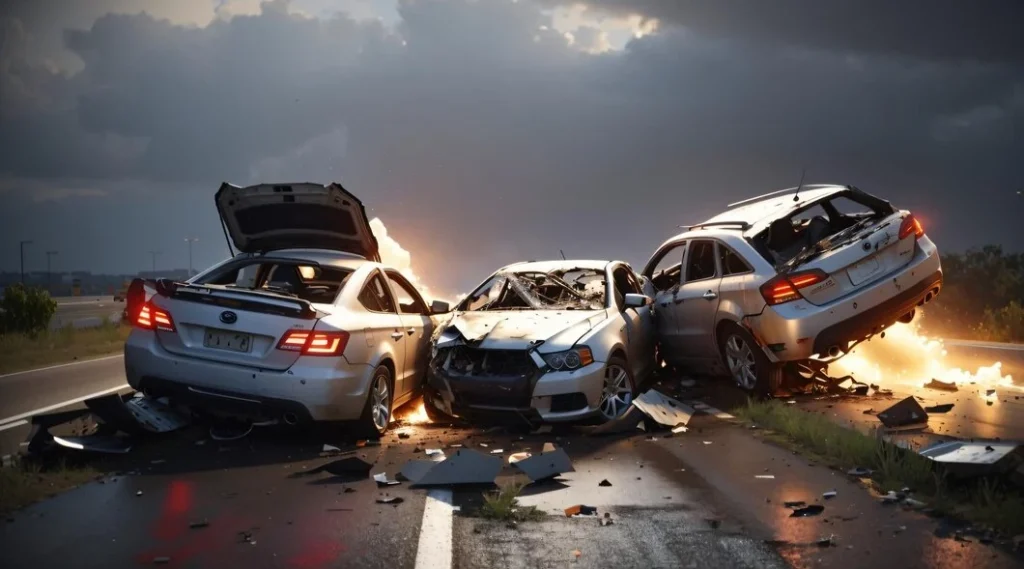personal injury lawyers
Fighting for maximum injury compensation for you and your family
No Fees Until We Win


Who’s At Fault in a Rear-End Accident in NJ?
In New Jersey, figuring out who’s at fault after a rear-end car accident is tricky.
This guide will walk you through the causes of these crashes, what you should do right after one happens, how fault is determined, the most common injuries, and ways to get compensated.
We’ll also talk about the importance of getting in touch with a skilled car accident lawyer in New Jersey who can help you navigate through these challenging situations.
Whether you’re driving on the busy roads of Newark or along the scenic routes of the Jersey Shore, this information is crucial for all New Jersey drivers.

Major Elements Causing Rear-End Collisions in New Jersey
Rear-end collisions in New Jersey often happen due to various factors. Understanding these can help drivers stay safer on the road.
- Distracted Driving: A top cause of rear-end accidents. This includes using cell phones, eating, or any activity that takes attention away from driving. For instance, a driver distracted by their phone on the busy New Jersey Turnpike is more likely to cause a rear-end collision.
- Tailgating: Following another car too closely, especially on highways like the Garden State Parkway, leaves insufficient time to react and stop, leading to rear-end accidents.
- Speeding: Driving too fast for conditions or over the speed limit increases the risk of not stopping in time, resulting in rear-end crashes. Speeding on roads with frequent stop-and-go traffic, like those in urban areas of Newark or Jersey City, is particularly risky.
- Sudden Stops: When drivers brake suddenly, especially in heavy traffic areas or near local workplaces during rush hours, the following vehicle might not have enough time to stop, causing a rear-end collision.
- Poor Weather Conditions: Rain, snow, and icy conditions can make roads slippery, increasing stopping distances. A vehicle traveling on a wet road in Trenton, for example, might not stop in time, leading to a rear-end accident.
- Traffic Congestion: During peak hours, the stop-and-go traffic on highways and city roads increases the likelihood of rear-end accidents.
Steps to Take After a Rear-End Collision in New Jersey
Being involved in a rear-end collision in New Jersey can be stressful. Here’s what you should do:
- Check for Injuries: First, make sure you and others are not hurt. Safety is the priority.
- Call 911: Report the accident to the authorities, especially if there are injuries or significant damage.
- Exchange Information: Get the other driver’s contact and insurance details.
- Document the Scene: Take photos of the vehicles, road conditions, and any landmarks. For example, if you’re near the Garden State Parkway, note that.
- Gather Witnesses: If anyone saw the accident, get their contact information.
- Seek Medical Attention: Even if injuries seem minor, a doctor’s visit is crucial. It ensures your health and provides medical records for insurance claims.
Determining Fault in Rear-End Car Accidents in New Jersey
Determining who is at fault in rear-end car accidents in New Jersey involves understanding specific state laws and traffic regulations:
New Jersey’s Distance Rule
State law (N.J.S.A 39:4-89) specifies that the distance between two vehicles in the same lane, traveling at 10 mph, should be about the length of a car (approximately 15 to 17 feet).
If this distance can’t be maintained, drivers should follow the three-second rule to ensure a safe gap between vehicles.
Typical Fault Assignments
Generally, the driver behind is blamed for rear-end collisions. This is because they are expected to maintain a safe distance, allowing them to react quickly to any sudden changes from the car in front.
Exceptions to the Rule
The rear driver is not always at fault. Exceptions include:
- If another driver cuts them off without observing a safe distance.
- If the collision is caused by factors beyond the rear driver’s control, like road hazards or adverse weather conditions.
- If the front driver abruptly slams on the brakes or reverses into the rear car.
Comparative Negligence in New Jersey
The state’s comparative negligence rule can come into play, where both the front and rear drivers may be found partly responsible for the accident.
Compensation may be adjusted based on each driver’s contribution to the collision.
Common Personal Injuries from Rear-End Collisions
Rear-end collisions, common on busy roads like the New Jersey Turnpike or near workplaces in Newark, can cause various injuries. Understanding these common injuries is crucial for drivers:
Whiplash
Whiplash is a neck injury that happens when the head is suddenly jerked forward and backward. It’s very common in rear-end accidents.
Symptoms: Neck pain, stiffness, headaches.
Report: The National Highway Traffic Safety Administration (NHTSA) reports that most whiplash injuries occur at speeds below 12 mph.
Back Injuries
The impact of a rear-end collision can hurt the spine.
Types: Herniated discs, spinal fractures.
Risk Areas: Especially on roads with frequent stop-and-go traffic.
Head Injuries
These can occur if you hit the steering wheel, dashboard, or windows.
Types: Concussions, lacerations.
Prevention: Good headrest positioning can help reduce the risk.
Seat Belt Injuries
While seat belts are crucial for safety, they can cause injuries in a crash.
Common Issues: Bruising along the chest, shoulder pain.
Airbag Injuries
When airbags deploy in a crash, they can cause injuries.
Types: Facial abrasions, burns.
Getting Compensation After a Rear-End Collision
Getting compensation after a rear-end collision in New Jersey involves a few key steps:
File an Insurance Claim
- Contact your insurance company immediately after the accident.
- Provide details like when and where the accident happened (e.g., on a busy road like the New Jersey Turnpike or near a local landmark in Newark).
Document Everything
- Take photos of the accident scene and any damage to your vehicle.
- Keep records of medical treatments if you’re injured.
Understand New Jersey’s No-Fault Insurance
- New Jersey follows a no-fault insurance system, which means your own insurance company pays for your medical expenses and lost wages, regardless of who caused the accident (N.J.S.A. 39:6A-4).
Consider Legal Action for Serious Injuries
- If you have serious injuries, you might be able to step outside the no-fault system.
- You can file a personal injury lawsuit against the driver at fault for pain and suffering and other non-economic losses.
Consult an Attorney
- An experienced car accident attorney can help you understand your rights.
- They can negotiate with insurance companies and file a lawsuit if necessary.
Contacting an Experienced Car Accident Attorney in New Jersey
Contacting an experienced car accident attorney in New Jersey can be a crucial step after being involved in a vehicle accident. Here’s why and what you should look for:
- Understanding Local Laws: New Jersey’s roadways, like the bustling Garden State Parkway or the busy streets of Newark, have specific traffic laws. An experienced attorney knows these laws inside out.
- Navigating Insurance Claims: They can help you deal with insurance companies, ensuring you get fair compensation.
- Dealing with Complex Cases: For accidents on major roads or near workplaces where multiple parties might be involved, legal expertise becomes even more important.
For professional legal guidance in rear-end accident cases in New Jersey, consider reaching out to Rosengard Law Group.
Their experience in handling such cases can provide you with the necessary support and expertise to navigate through the legal process effectively.
What to Look For in an Attorney
- Specialized Experience: Choose someone who has handled car accident cases in New Jersey specifically.
- Success Rate: Look at their track record in similar cases.
- Communication: They should explain things in simple language and keep you updated.
FAQs
Are Rear End Collisions Always the Rear Driver’s Fault in New Jersey?
In New Jersey, rear-end collisions are generally considered the fault of the rear driver, but there are exceptions depending on the specific circumstances of each accident.
What Does New Jersey Law Say About Rear-End Collisions?
New Jersey law typically holds the rear driver responsible in rear-end collisions, based on the presumption that they failed to maintain a safe following distance.
However, there are exceptions where the leading driver may be at fault, depending on the specific circumstances of the accident.
Conclusion
In New Jersey, determining fault in rear-end accidents usually focuses on the rear driver, but exceptions exist.
Knowing the right steps to take and when to seek legal help is crucial for anyone involved in such an incident.
Remember, injuries like whiplash are common, so care is crucial. If injured, filing a claim or consulting an experienced attorney can help in securing fair compensation.
Always stay informed and prepared, as this knowledge is key to effectively handling rear-end collisions in New Jersey.

Free Injury Case Evaluation
Send the form below and we will call you back in minutes.
…or Call Us Now
856-284-6446
